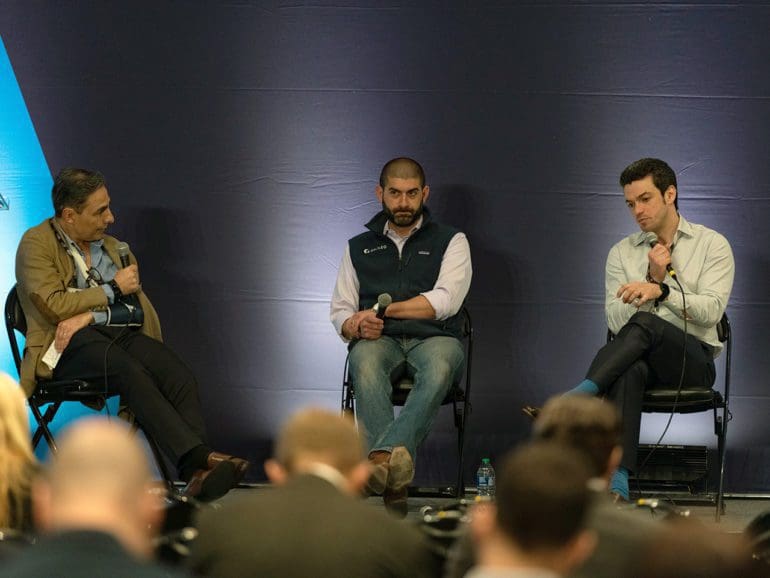Banking is clearly amid its digital transformation, but plenty of companies still have to make a move.
Constant innovation also means that maintaining a digital presence continually needs attention.
The digital experience was a popular topic at Fintech Nexus 2022 in New York City, where an entire one-day stream was devoted to it. Industry figures discussed partnerships, starting from scratch, and what comes next.
Why startups have the digital banking edge
Startups have distinct advantages when designing their tech stacks.
Back in the day, when banking was mostly branch-based, and transactions were completed in person, some standard industry tech systems worked well. Then came the COVID-19 pandemic, which turbocharged digital adoption.
Everyone needed overnight digital onboarding, online identity verification, and remote payment capability. Banks, used to decades of people eating what’s put in front of them, were left ill-prepared.
Such institutions are starting from a deficit because it is hard to build on top of legacy infrastructure successfully,
SynapseFi’s Sankaet Pathak said. Apps need more throughput than is what is usually present. That is one reason why most banks are still operating with legacy cores.
TrueNorth’s Agustin Sanchez speaks with many community banks who want to expand their reach. They want to integrate into existing APIs and use BaaS systems. How do they transition out of their legacy cores? By working with implementation partners, such banks can begin by selecting core components off the shelf. This allows them to start small with a few products.
That simplicity is essential when you are stitching technologies into non-core-competent areas, LoanPro’s Rhett Roberts added. Beginning small allows companies to avoid a complete teardown in favor of parallel incremental migrations.
How to find the proper digital banking partner
The importance of partnerships was a key track theme, and nowhere are they more important than for non-banks wishing to offer banking.
“The playbook for someone who’s not a bank is tedious but straightforward,” Sanchez said. “You have to find a sponsor bank; you have to find a KYC vendor, you have to find a transaction monitoring system, you have to find a payment processor, you have to find the core banking system, you have to find a card printer, you have to find the card network (and) you have to find the ACH processor.”
The alternative is to partner with the right companies, so all you have to do is lend, Sanchez added. This is popular with immigrant groups and even small community sports teams. Anyone who has a brand has an opportunity.
A digital presence is a given, but institutions must also differentiate in this sphere. Luckily, there is plenty of opportunities, Galileo Financial Technologies’ chief financial officer Seth McGuire said.
Begin with SMB and B2B activity. Business owners enjoy a high level of sophistication in their personal banking and wonder why it is absent in the business realm. SMBs still drop off cash at a branch, write cheques and use ledgers. That leaves plenty of room for innovation.
What does your customer want now?
Now that consumers are comfortable with digital banking, their demands have gone beyond low fees and ease of use, Current’s VP of finance David Kilin said.
They now expect these institutions to solve specific problems. Ignore this at your peril, he warned. The days of the decades-long customer taking what they’re given are gone. Switching brands is easy as rolling out products can lure customers away.
“In the digital world, it is incumbent on us to figure out what specific problems we are solving and move to solve them,” Kilin said. He added that startups had not addressed money management, a high-demand area.
Another top area is secured credit, McGuire said. Satisfied customers want to continue their journey, and credit is a way to keep them around.
Startups are quickly grabbing market share and satisfying customers for a few reasons. Kilin said they tend to focus on small groups with specific needs while incumbents are more generically oriented. It is increasingly hard to service all groups especially.
Technology also hinders incumbents, McGuire added. Banks must add to an already complex infrastructure layer while startups build towards the desired experience.
Fintechs also have the opportunity to learn more about their customers. When the move to desktop was underway, 30% of account holders checked once a week. That figure moved to 70% with the advent of mobile. Now, 70% check their accounts daily.
“That increased level of engagement gives us so many more opportunities to actually learn about what our customers want, to interact with them, to give them something, to learn from them, and then service them better,” McGuire said.
Things will go wrong, Kilin added. Address those mistakes by working with your technology partners to improve faster than banks.
Factors driving an exceptional UX?
It takes more than great technology to deliver a supreme UX, M1 Finance’s Brian Barnes said. At a macro level, acquire a bank and combine that with the solid technology you develop. The reason? That bank will have completed all of the regulatory hurdles.
The premier financial services experience is enjoyed by the ultra-wealthy, Barnes explained. What do they get that others don’t? How can you bring those experiences to more people?
Thought Machine’s Travers Clarke-Walker said that traditional core banking systems and banks’ back ends don’t fare well in modern contexts. The breadth of what is required to provide a modern banking experience is broad, and even if you were to achieve success, by the time you do, your technology would be outdated.
The solution? Complete it iteratively over time, he suggested. That makes for an exciting environment with the bonus of being attractive to employees.
Where does BNPL fit into the digital banking experience?
Do your fintech plans include BNPL capability? Strongly consider having a significant payment network backing the service, Mastercard’s Chiro Aikat said. The pandemic caused a shift in how consumers view payments, with 80% more open to emerging technologies.
“That trend is here to stay,” Aikat said. “More and more consumers are getting comfortable, more and more want a digital experience more and more want an e-commerce experience as well.”
He added that more than 60% want BNPL services from a trusted entity. They also want more choices and to have more merchants offer the service. Think beyond traditional retail for the opportunity, too, Aikat advised. Small businesses and medical offices are two examples.
Not every scenario is suitable for BNPL, he cautioned. Mastercard limits it to the spending of at least $50. Some categories do not make sense.
Consumers expect the same BNPL experience in-store as they do online, Aikat said. Some tools are digital tokens and virtual cards in consumer wallets that can be used for contactless payments. Tap on a POS system and complete your purchase. The industry hasn’t completely solved this, he said. It’s worth the work, as BNPL has added 35% to the average basket size.
Key partnership considerations
Partnerships are a road to success, but several factors must be considered before shaking hands. At Alliant Credit Union, Robert Perrelli looks beyond transactions to long-term relationships. How do the prospective partner company’s culture, goals, and objectives align with yours? How transparent are they?

“It’s critical because we all have finite resources,” Perrelli said. “I need to identify partners that make us better, and in return, we can help them achieve their goals and successes as well.”
At NovoPayment, they consider three factors, Anabel Perez said. What is their culture? What stage of their transformational process are they in (that helps you identify resources)? What value is gained by a partnership, and how do you measure it?
As rates rise, look at prospective partners’ performance on every tier they have, Ridgewood Savings Bank’s Art Saitta noted. Most fintechs are older than two years, so you should have performances in multiple environments to assess. Consider if that possible partner is looking to get acquired.
In closing, Saitta said carefully consider the many regulatory issues a partnership can bring.
“Let’s also look at it sheer madness as to the number of regulatory agencies because fintechs are involved with every possible aspect of finance, and now also with things that we never considered imaginable three or four years ago.”


